Friction Weldability of a High Nb Containing TiAl Alloy
Abstract
1. Introduction
2. Experimental
2.1. Materials
2.2. Selection and Optimization of Welding Parameters
2.3. Macro- and Microstructure and Tensile Properties Analyses
3. Results and Discussion
3.1. Microstructures of the As-Cast and As-Forged Alloys
3.2. Joints of the Trial Welding Specimens
3.2.1. The Appearances
3.2.2. Macrostructures of the Welding Joints
3.3. Optimized Process and Welding Results
3.4. Structure of the Specimens Welded by the Optimized Process
3.4.1. Macrostructures
3.4.2. The Microstructure of the CJ
3.4.3. The Microstructure of FJ
3.5. Tensile Properties and Weldability Assessment
3.5.1. Tensile Properties of the Joints
3.5.2. Weldability Assessment
4. Conclusions
- (1)
- After trial welding, cylindrical rods of the Ti-45Al-8.5Nb-0.2W-0.2B-0.02Y alloy with both as-cast (NL) and as-forged (DP) microstructures have been successfully welded by rotary friction welding with an optimized process. Each joint has a severe deformation zone (SDZ) with a biconcave lens geometry. The thickness of the SDZ is dozens of micrometers to hundreds of micrometers from the center to periphery. Each joint has a TZ between SDZ and PM, which is hundreds of micrometers in thickness.
- (2)
- Irrespective of the initial microstructure, all SDZs shows a fine DP microstructure with a grain size of a few micrometers due to complete recrystallization occurring in these zones over a short period of time.
- (3)
- The TZ of the joint of the as-cast alloy consists of a large volume fraction of deformed lamellar colonies and a small part of partially recrystallized grains in a NL morphology. This is attributed to the fact that recrystallized grains align along the initial lamellar direction whereas new lamellar colonies keep a similar orientation with the initial one. The retained NL structure has blurred lamellar interfaces. This is owing to the intersection of deformation twins, the lamella growing into adjacent lamellae, and the lamellae thinning by the as-cast lamellae → α → new lamellae transformation.
- (4)
- The TZ of the joint of the as-forged alloy is a DP microstructure. The grain size, the volume fraction of γ grain and the volume fraction of the remnant lamellae all increase with the increase of the distance from SDZ. Full recrystallization occurred in some remnant lamellar colonies.
- (5)
- Under tensile stress, all the joints failed in PMs in brittle fracture mode: CJ mainly showed translamellar failure and FJ showed transgranular cleavage and translamellar failure.
- (6)
- The sound and stronger CJ and FJ show that Ti-45Al-8.5Nb-0.2W-0.2B-0.02Y alloy has good friction weldability.
Author Contributions
Funding
Conflicts of Interest
Abbreviations
| BSE | Backscattered electron |
| CJ | Joint of as-cast alloy |
| CLSM | Confocal laser microscope |
| DP | Duplex |
| EDM | Electrical discharge machining |
| FJ | Joint of as-forged alloy |
| LCr | Fine recrystallized lamellar colonies |
| LCc | Lamellar colonies in as-cast alloy |
| NL | Nearly lamellar |
| PE | Plastic elongation at fracture |
| PM | Parent metal |
| PWHT | Post-welding heat treatments |
| RFW | Rotary friction welding |
| SDZ | Severely deformation zone |
| SEM | Scanning electron microscope |
| TZ | Transition zone |
| TEM | Transmission electron microscope |
| UTS | Ultimate tensile strength |
| ω | Rotation speed |
| Pf | Friction pressure |
| δL | Friction burn-off distance |
| dL | Upset distance |
| ΔL | Size reduction of the specimen |
| Pu | Upset pressure |
| Upset rate |
References
- Clemens, H.; Kestler, H. Processing and applications of intermetallic γ-TiAl-based alloys. Adv. Eng. Mater. 2000, 2, 551–570. [Google Scholar] [CrossRef]
- Appel, F.; Brossmann, U.; Christoph, U.; Eggert, S.; Janschek, P.; Lorenz, U.; Müllauer, J.; Oehring, M.; Paul, J.D.H. Recent progress in the development of gamma titanium aluminide alloys. Adv. Eng. Mater. 2000, 2, 699–720. [Google Scholar] [CrossRef]
- Kim, S.W.; Hong, J.K.; Na, Y.S.; Yeom, J.T.; Kim, S.E. Development of TiAl alloys with excellent mechanical properties and oxidation resistance. Mater. Des. 2014, 54, 814–819. [Google Scholar] [CrossRef]
- Appel, F.; Paul, J.D.H.; Oehring, M. Gamma Titanium Aluminide Alloys: Science and Technology; Wiley-VCH Verlag GmbH and Co. KGaA: Weinheim, Germany, 2011. [Google Scholar]
- Lin, J.P.; Zhao, L.L.; Li, G.Y.; Zhang, L.Q.; Song, X.P.; Ye, F.; Chen, G.L. Effect of Nb on oxidation behavior of high Nb containing TiAl alloys. Intermetallics 2011, 19, 131–136. [Google Scholar] [CrossRef]
- Liu, Z.C.; Lin, J.P.; Li, S.J.; Chen, G.L. Effects of Nb and Al on the microstructures and mechanical properties of high Nb containing TiAl base alloys. Intermetallics 2002, 10, 653–659. [Google Scholar] [CrossRef]
- Lin, J.P.; Xu, X.J.; Wang, Y.L.; He, S.F.; Zhang, Y.; Song, X.P.; Chen, G.L. High temperature deformation behaviors of a high Nb containing TiAl alloy. Intermetallics 2007, 15, 668–674. [Google Scholar] [CrossRef]
- Kim, Y.W.; Kim, S.L. Advances in gammalloy materials–processes–application technology: Successes, dilemmas, and future. JOM 2018, 70, 553–560. [Google Scholar] [CrossRef]
- Cao, J.; Qi, J.; Song, X.; Feng, J. Welding and joining of titanium aluminides. Materials 2014, 7, 4930–4962. [Google Scholar] [CrossRef]
- Cam, G.; Ipekoglu, G.; Bohm, K.-H.; Kocak, M. Investigation into the microstructure and mechanical properties of diffusion bonded TiAl alloys. J. Mater. Sci. 2006, 41, 5273–5282. [Google Scholar] [CrossRef]
- Hurta, S.; Clemens, H.; Frommeyer, G.; Nicolai, H.P.; sibum, H. Valves of intermetallic gamma-TiAl-based alloys: Processing and properties. In Titanium’ 95: Science and Technology; Institute of Materials: London, UK, 1996; pp. 277–286. [Google Scholar]
- Schmicker, D.; Naumenko, K.; Strackeljan, J. A robust simulation of direct drive friction welding with a modified Carreau fluid constitutive model. Comput. Methods Appl. Mech. Eng. 2013, 265, 186–194. [Google Scholar] [CrossRef]
- Miyashita, T.; Hino, H. Friction welding characteristics of TiAl intermetallic Compound. J. Jpn. Inst. Met. 1994, 58, 215–220. [Google Scholar] [CrossRef][Green Version]
- Shinoda, T.; Ito, K.; Hayashi, C. Friction welding of TiAl intermetallic compound. Weld. Int. 1997, 11, 200–205. [Google Scholar] [CrossRef]
- Bohm, K.H.; Ventzke, V.; Kocak, M.; Merhof, P.; Watzlaw, M. Parameter study into the friction welding of the intermetallic TiAl and the alloy Ti6Al4V. Weld. Cut. 2003, 55, 90–96. [Google Scholar]
- Sankar, G.S.; Karthik, G.M.; Mohammad, A.; Kumar, R.; Ram, G.D.J. Friction welding of electron beam melted γ-TiAl alloy Ti–48Al–2Cr–2Nb. Trans. Indian Inst. Met. 2019, 72, 35–42. [Google Scholar] [CrossRef]
- Midling, O.T.; Grong, Ø. A process model for friction welding of Al-Mg-Si alloys and A-SiC metal matrix composites—I. HAZ temperature and strain rate distribution. Acta Metall. Mater. 1994, 42, 1595–1609. [Google Scholar] [CrossRef]
- Kainuma, R.; Fujita, Y.; Mitsui, H.; Ohnuma, I.; Ishida, K. Phase equilibria among α (hcp), β (bcc) and γ (L10) phases in Ti–Al base ternary alloys. Intermetallics 2000, 8, 855–867. [Google Scholar] [CrossRef]
- Witusiewicz, V.T.; Bondar, A.A.; Hecht, U.; Rex, S.; Velikanova, T.Y. The Al–B–Nb–Ti system: III. Thermodynamic re-evaluation of the constituent binary system Al–Ti. J. Alloy. Compd. 2009, 472, 133–161. [Google Scholar] [CrossRef]
- Xu, X.J.; Lin, J.P.; Wang, Y.L.; Chen, G.L. Deformability and microstructure transformation of pilot ingot of Ti-45Al-(8–9) Nb-(W, B, Y) alloy. Mater. Sci. Eng. A 2006, 416, 98–103. [Google Scholar] [CrossRef]
- Yilbas, B.S.; Sahin, A.Z. Friction Welding Thermal and Metallurgical Characteristics; Springer: New York, NY, USA; Heidelberg, Germany; Dordrecht, The Netherlands; London, UK, 2014. [Google Scholar]
- AMcAndrew, R.; Colegrove, P.A.; Addison, A.C.; Flipo, B.C.D.; Russell, M.J. Modelling the influence of the process inputs on the removal of surface contaminants from Ti–6Al–4V linear friction welds. Mater. Des. 2015, 66, 183–195. [Google Scholar] [CrossRef]
- Song, L.; Xu, X.; You, L.; Liang, Y.; Lin, J. Ordered ω phase transformations in Ti-45Al-8.5Nb-0.2B alloy. Intermetallics 2015, 65, 22–28. [Google Scholar] [CrossRef]
- Gao, S.; Xu, X.; Shen, Z.; Ye, T.; Xu, S.; Lin, J. Microstructure and properties of forged plasma arc melted pilot ingot of Ti–45Al–8.5Nb–(W, B, Y) alloy. Mater. Sci. Eng. A 2016, 677, 89–96. [Google Scholar] [CrossRef]


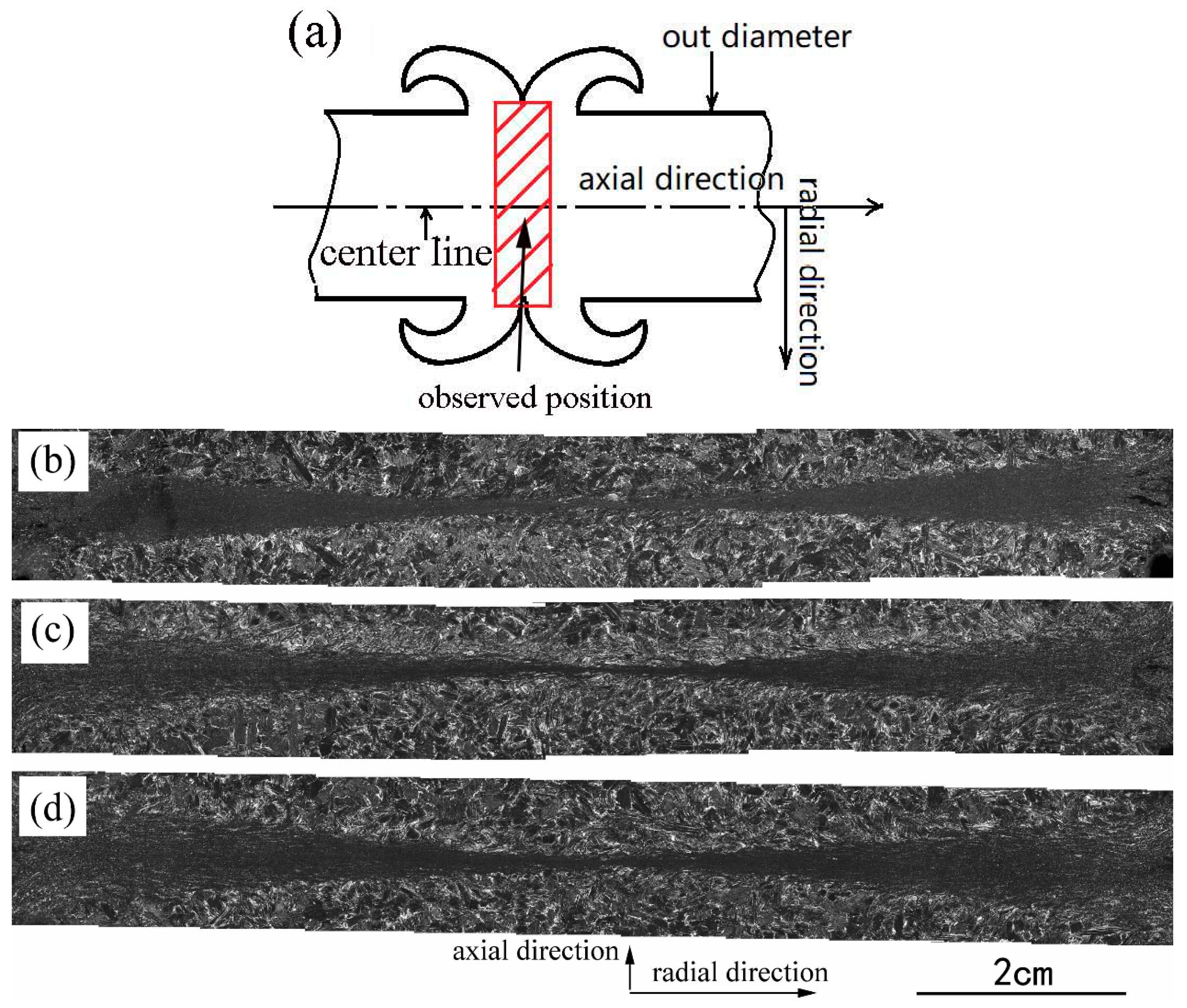
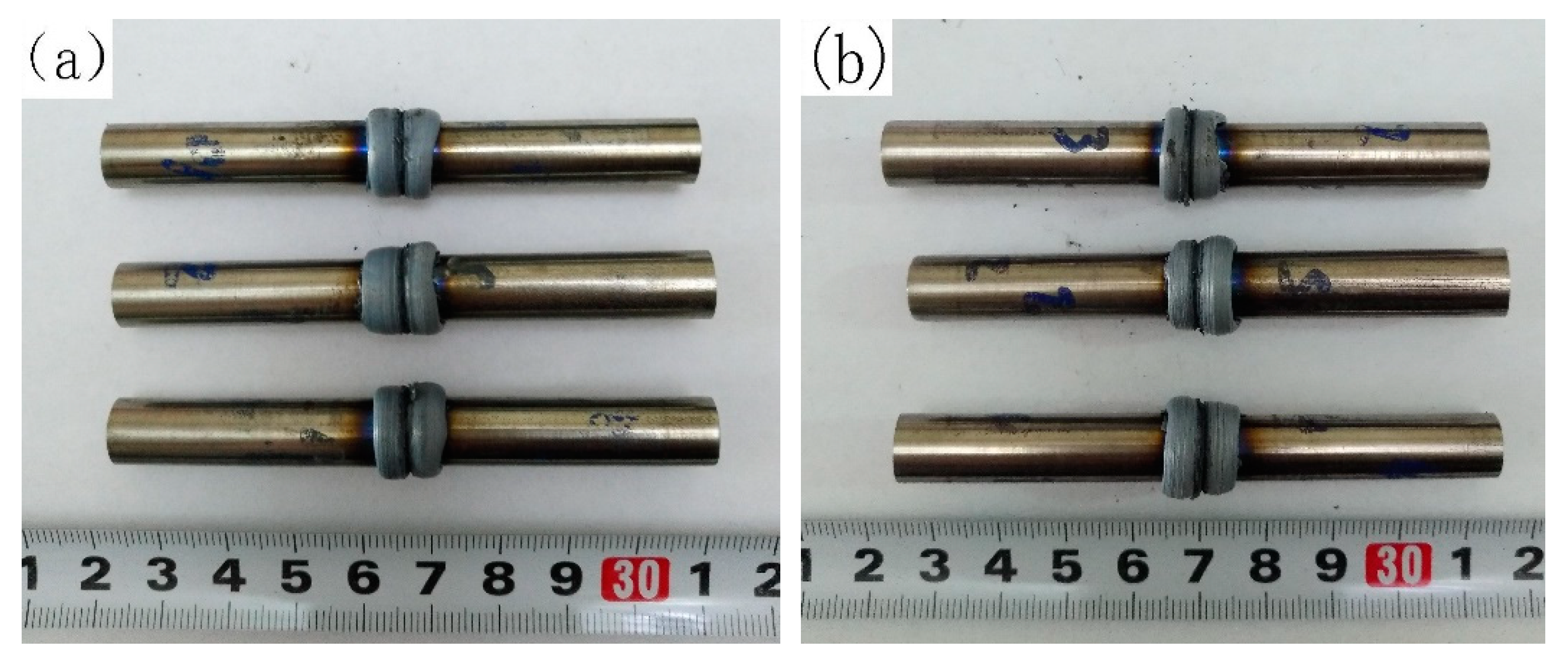
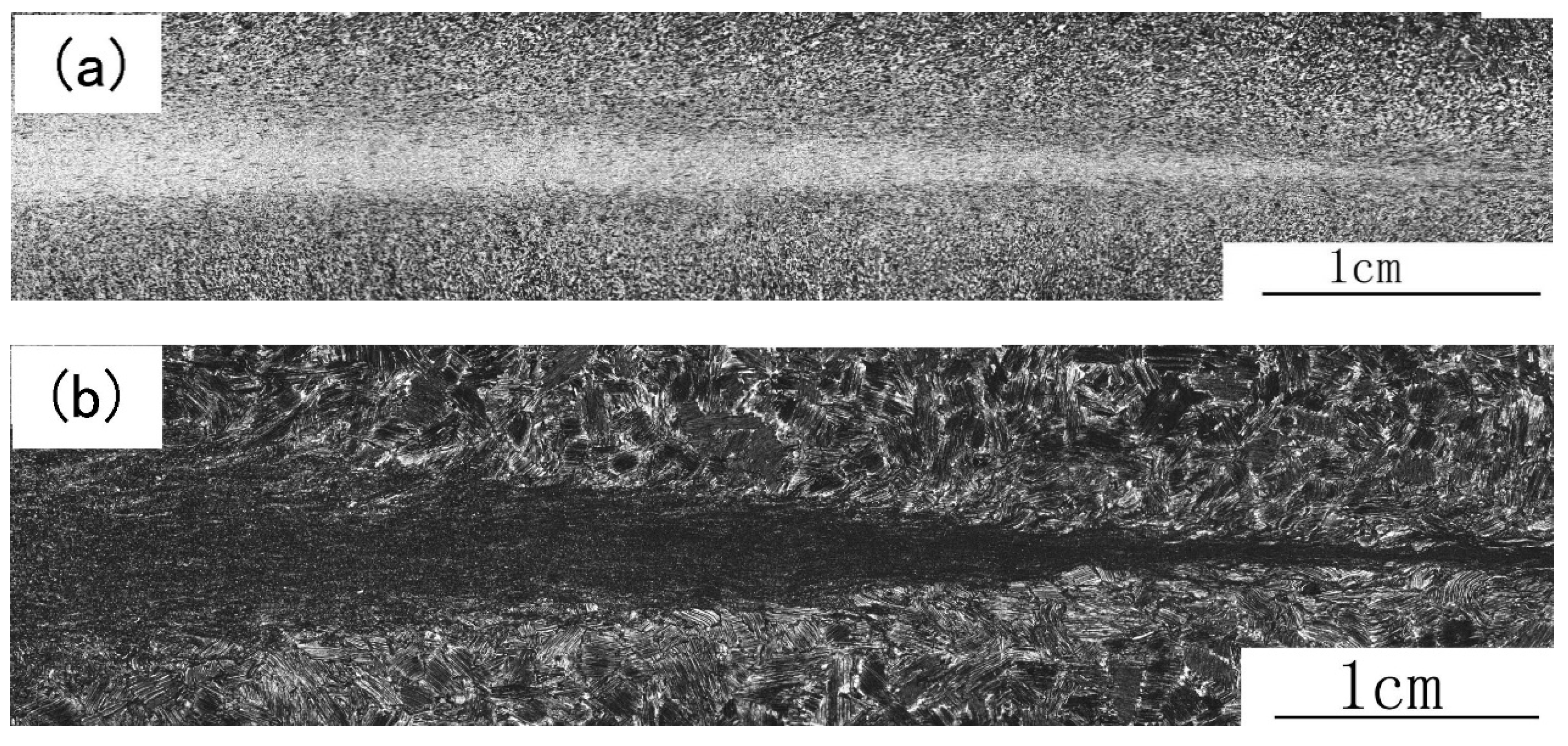
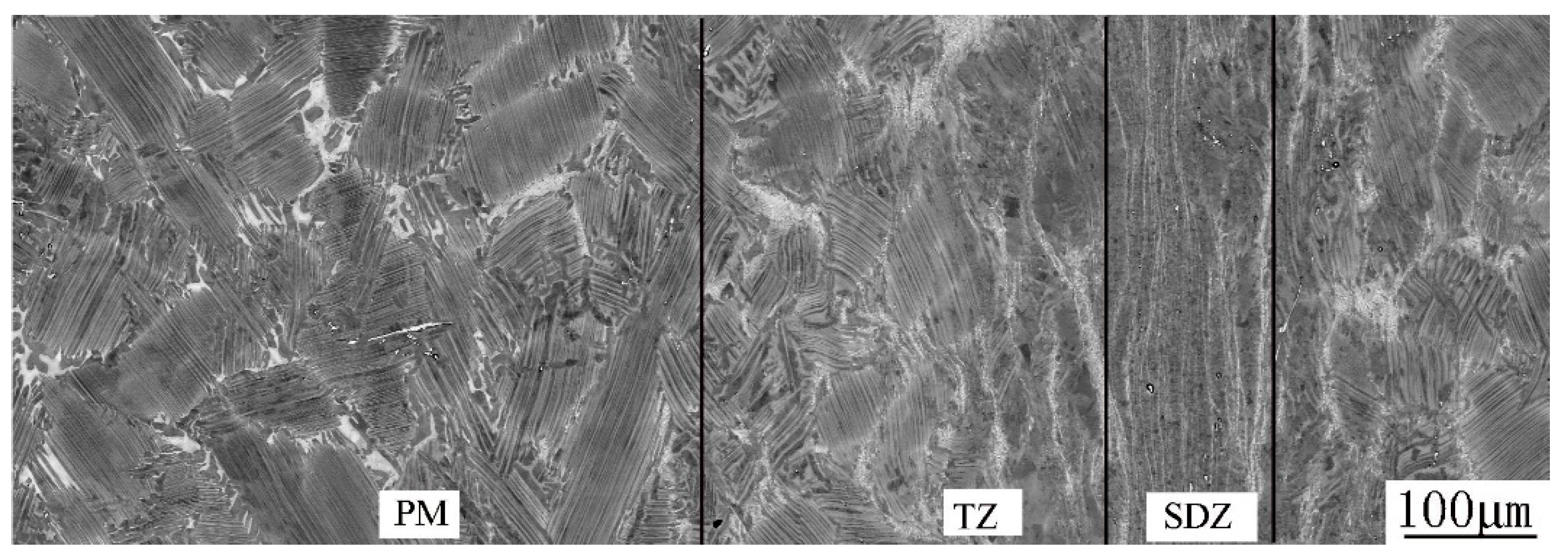


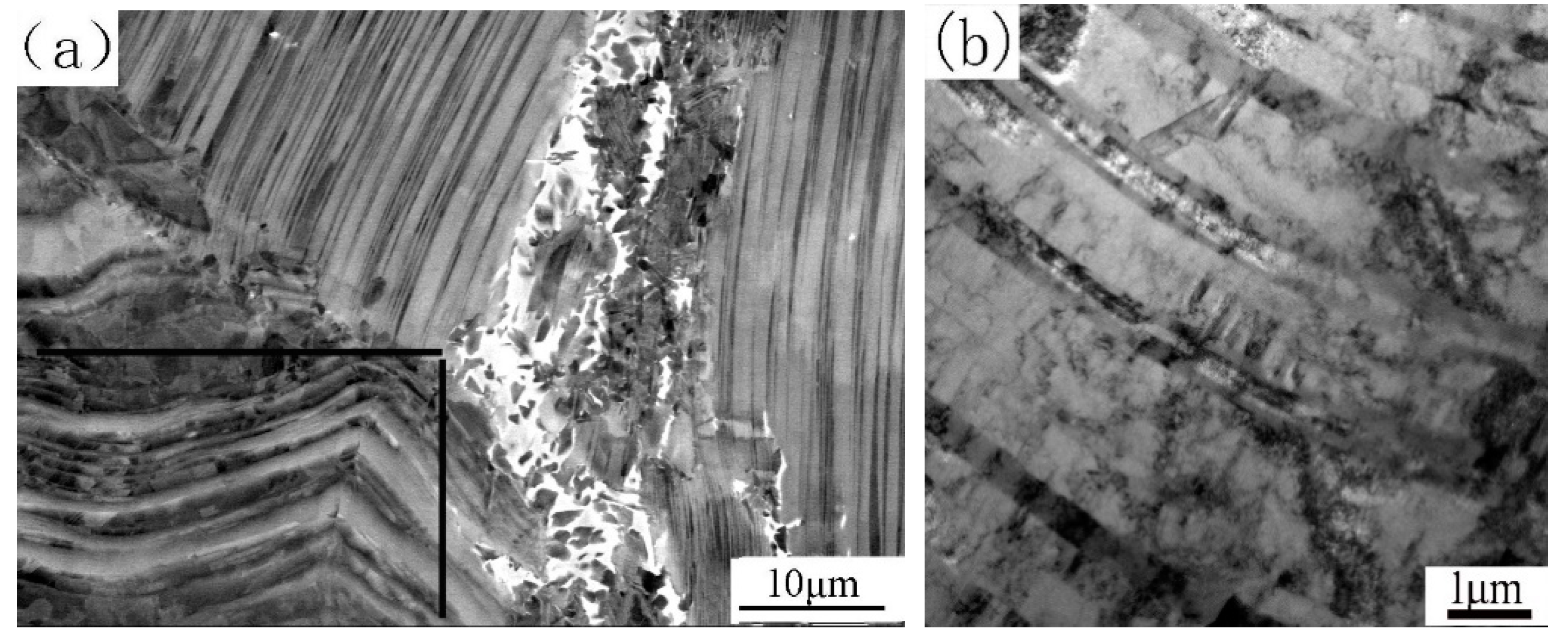
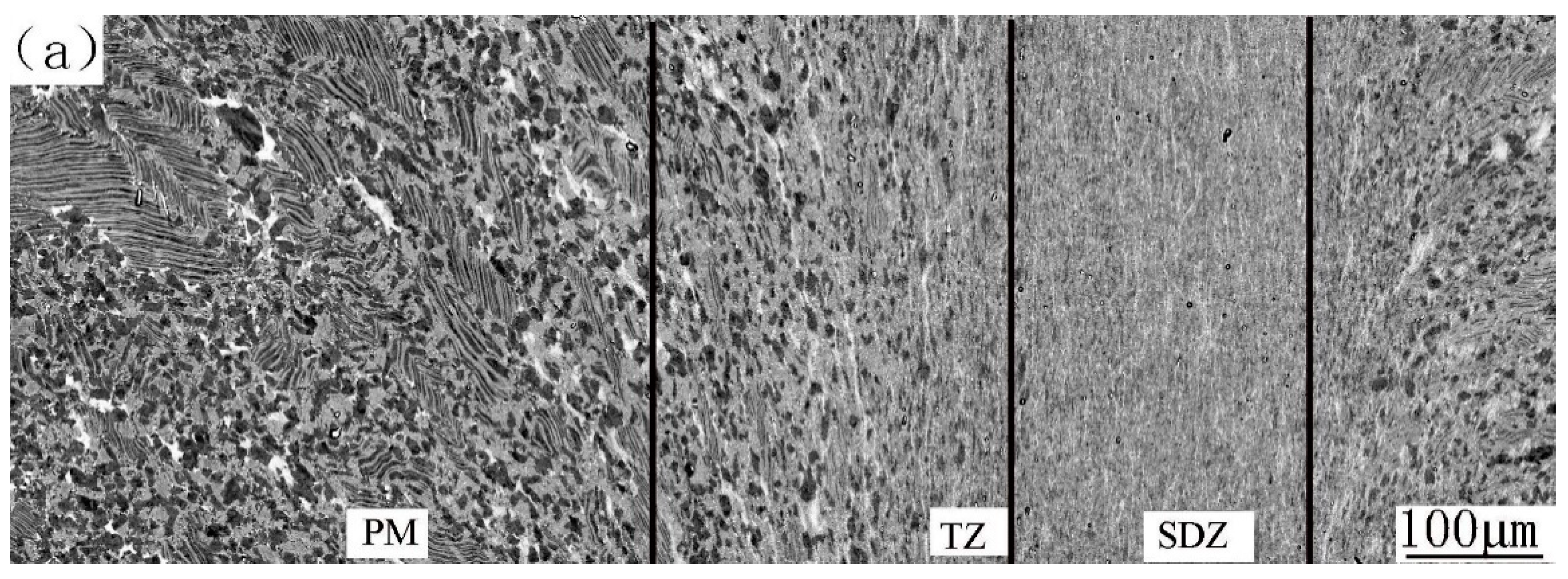
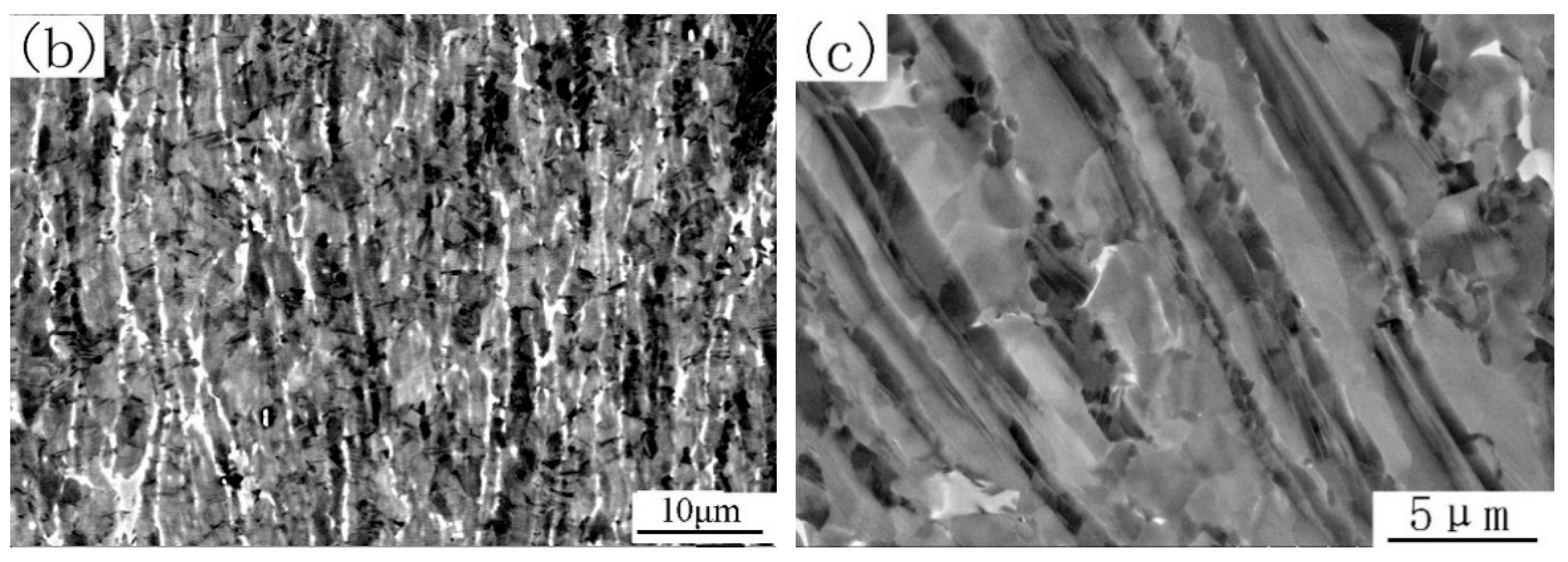

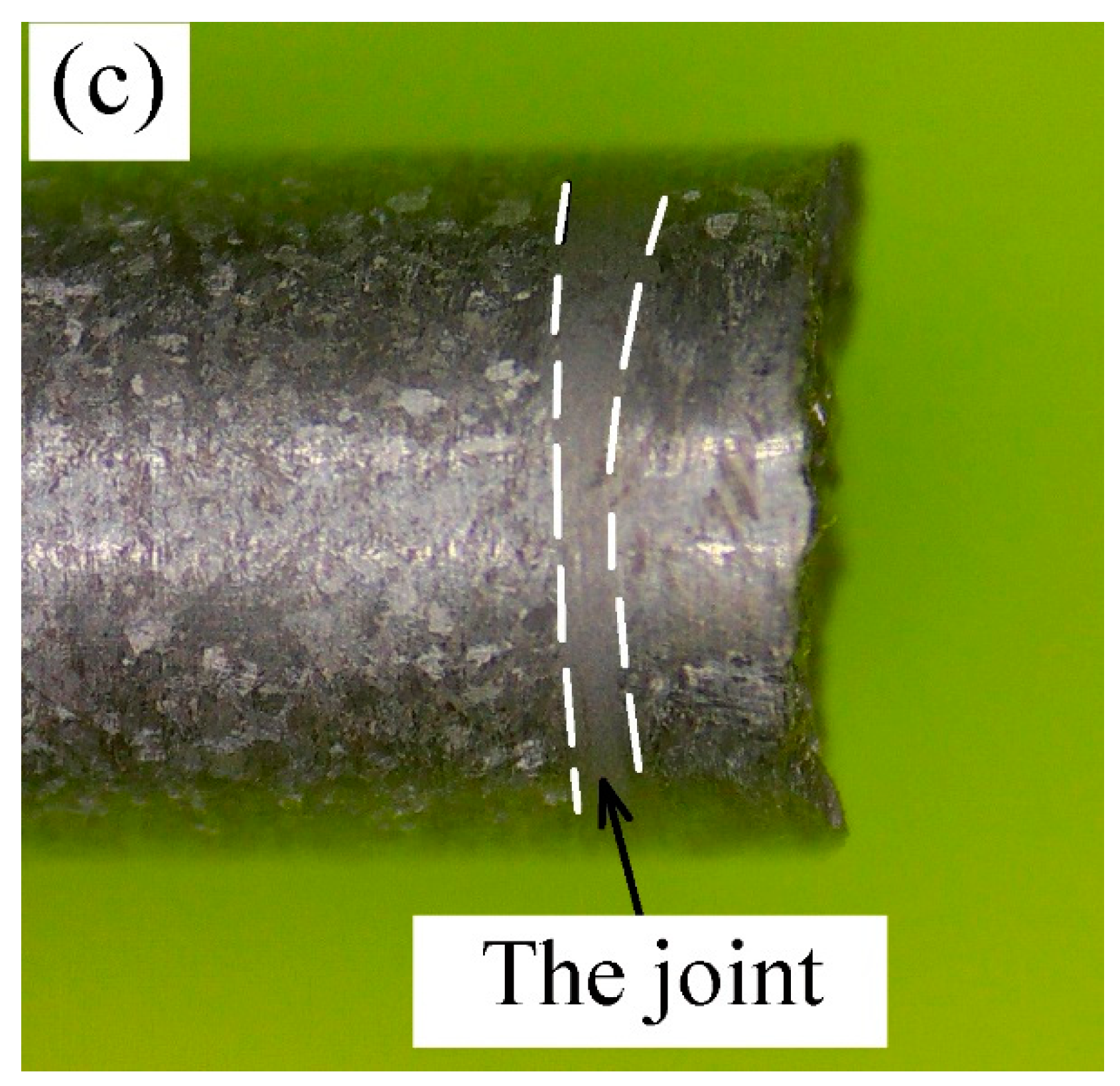

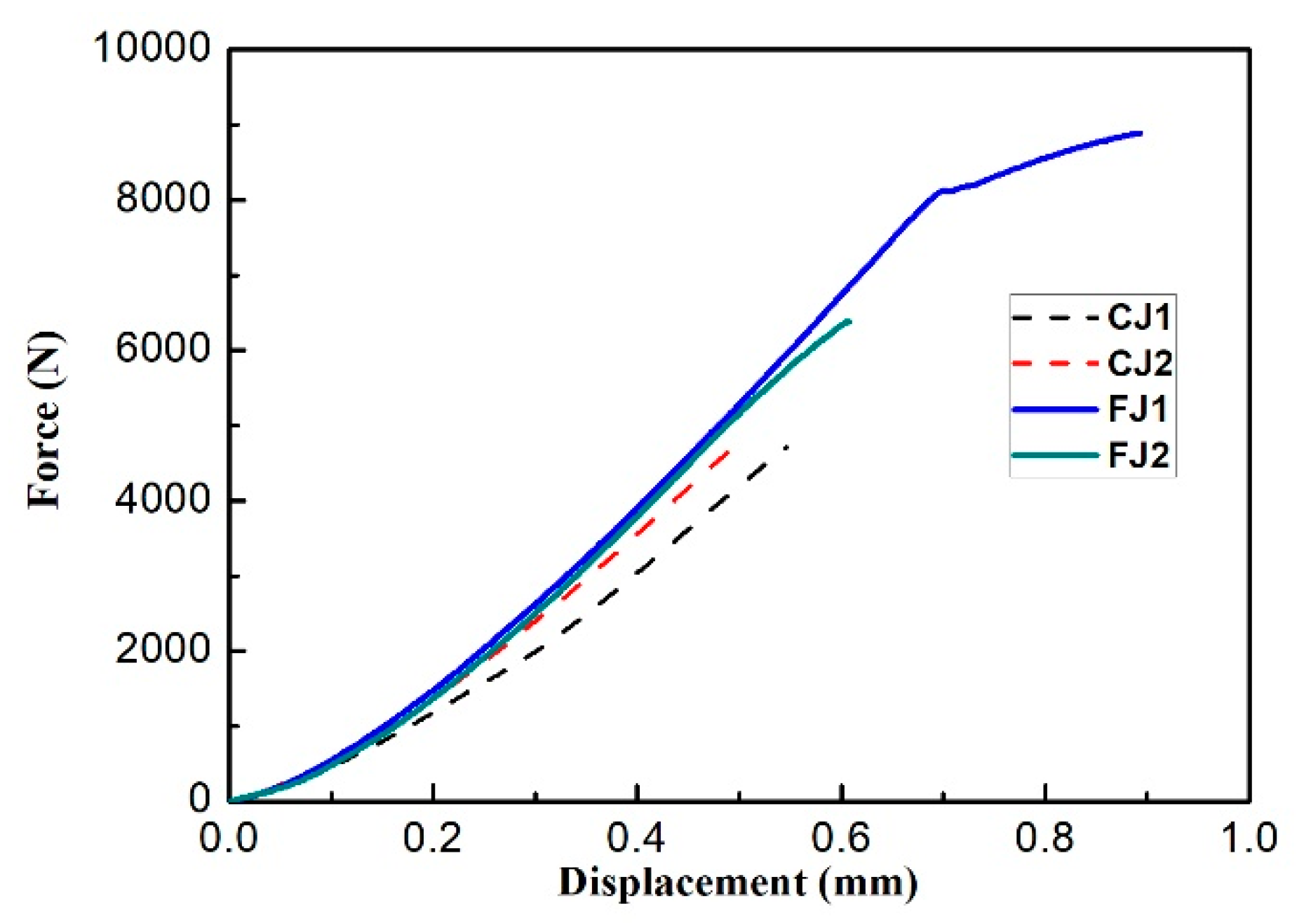
| Scheme | δL (mm) | Pf (MPa) | Pu (MPa) | (mm/s) | ΔL (mm) |
|---|---|---|---|---|---|
| 1 | 3 | 240 | 300 | 4 | 4.35 |
| 2 | 2 | 240 | 280 | 4 | 2.35 |
| 3 | 3 | 240 | 280 | 4 | 4.21 |
| 4 | 3 | 280 | 280 | 4 | 4.50 |
| 5 | 2 | 320 | 320 | 4 | 3.64 |
| 6 | 3 | 320 | 360 | 4 | 4.46 |
| 7 | 3 | 320 | 360 | 20 | 3.98 |
| 8 | 3 | 360 | 360 | 4 | - |
© 2019 by the authors. Licensee MDPI, Basel, Switzerland. This article is an open access article distributed under the terms and conditions of the Creative Commons Attribution (CC BY) license (http://creativecommons.org/licenses/by/4.0/).
Share and Cite
Xu, X.; Lin, J.; Guo, J.; Liang, Y. Friction Weldability of a High Nb Containing TiAl Alloy. Materials 2019, 12, 3556. https://doi.org/10.3390/ma12213556
Xu X, Lin J, Guo J, Liang Y. Friction Weldability of a High Nb Containing TiAl Alloy. Materials. 2019; 12(21):3556. https://doi.org/10.3390/ma12213556
Chicago/Turabian StyleXu, Xiangjun, Junpin Lin, Jian Guo, and Yongfeng Liang. 2019. "Friction Weldability of a High Nb Containing TiAl Alloy" Materials 12, no. 21: 3556. https://doi.org/10.3390/ma12213556
APA StyleXu, X., Lin, J., Guo, J., & Liang, Y. (2019). Friction Weldability of a High Nb Containing TiAl Alloy. Materials, 12(21), 3556. https://doi.org/10.3390/ma12213556






